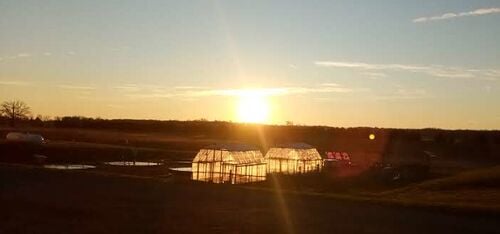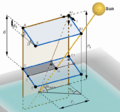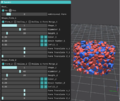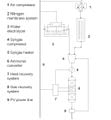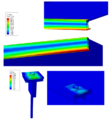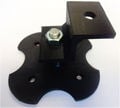To continue accelerating cost declines in the solar photovoltaic (PV) industry and take advantage of the opportunities of an open source approach, four novel objectives are targeted: 1) improve PV system performance with low-concentration reflectors without negating warranties, 2) develop PV systems for agriculture that farmers can deploy themselves, 3) use distributed recycling and additive manufacturing (DRAM) to cut PV racking costs, and 4) utilize flexible PV to eliminate the need for conventional racking all together. To do this we established the first completely open source outdoor PV testing center to meet these objectives: Western Innovation for Renewable Energy Deployment (WIRED). WIRED is a project focusing on agrivoltaics primarily in a partnership between the Ivey Business School and Western Engineering.
Using heavily monitored and wired PV systems, WIRED will explore new ways of radically reducing the costs of PV systems while improving their functionality by using open source racking and enabling PV to provide more value than using only green electricity. The ten sub-PV systems making up the heart of the proposed infrastructure will be large enough to act as industrially relevant proof-of-concepts and to obtain statistical data on performance of individually-monitored PV modules. WIRED will be completely open source, including the requested infrastructure for prototyping, monitoring, and the results, making it not only unique globally, but also well positioned to reduce PV system costs and accelerate PV deployment in Canada. The PV industry system designers and developers will be the primary users of the research outcomes although it will also be used by SMEs looking to minimize installation costs of PV.

WIRED, comprising about 1 hectare of area, will be located in Western's Field Station. The 33-hectare site features a 4-hectare area of intensively managed research plots and is a member of the Canadian Micro-Pulse Lidar Network, both of which will be leveraged for the agrivoltaic trials that are part of this research for time trials and long-term highly-monitored performance testing. The PV-generated electricity from the system will be fed into Western's Institute for Chemicals and Fuels from Alternative Resources (ICFAR) to provide a portion of the energy needs while complimenting their mission. Dr. Pearce's WIRED research program not only ties together two of Western's major research initiatives (WindEEE and ICFAR), but it is well aligned with one of Western University's signature research areas on Environmental Sustainability and Green Energy, and Western Engineering's research theme of Sustainability, Environment, Resiliency & Adaptive Systems.
WIRED also includes an agrivoltaic agrotunnel.
Met data we want[edit | edit source]
The first and foremost step to be taken in the feasibility assessment of PV modules, the long-term monitoring, their failure analysis for reliability studies and thereby providing useful testing standards for designers is to obtain local meteorological data, namely ambient temperature and pressure, wind speed and direction, relative humidity, dew point temperature, precipitation patterns, cloud cover, etc. These data have been aggregated from different sites all around the world and are available on various authentic data sources and websites.
Data availability on site[edit | edit source]
- https://mplnet.gsfc.nasa.gov/data?s=London-CDN&v=V3
- https://aeronet.gsfc.nasa.gov/new_web/photo_db_v3/London-CDN.html
Weather Data from London Airport[edit | edit source]
- https://weather.gc.ca/past_conditions/index_e.html?station=yxu
- https://www.worldweatheronline.com/london-weather-history/ontario/ca.aspx
Canada Weather Data[edit | edit source]
- https://climate.weather.gc.ca/historical_data/search_historic_data_e.html
- https://www.energyhub.org/solar-energy-maps-canada/
Weather Dashboard for London[edit | edit source]
Data/Parameters/Variables Planned to be monitored at WIRED[edit | edit source]
- Surface temperature of PV modules and micro climate under the panels through IR camera and temperature sensors
- Imaging of crops for AI/CV monitoring through a normal camera
- Power generated through PV modules through power sensors
- Strain gauge measurements for PV racking systems through strain gauges
- Soil moisture through moisture sensors
- Humidity measurements for the climate under the PV panels through humidity sensors
- Soil pH monitoring through pH sensors
- Irradiance measurements through pyranometers and spectrometers
- Weather monitoring such as wind speed, temperature, humidity etc. through a MET station
- Aerosol measurements
- https://aeronet.gsfc.nasa.gov/cgi-bin/data_display_aod_v3
- https://www.uwo.ca/sci/mplcan/
- PAR measurements through PAR sensor
- Apogee online calculator for PAR (clear sky) - https://clearskycalculator.com/quantumsensor.htm
Agrivoltaic Greenhouses[edit | edit source]
Agrivoltaics Racks[edit | edit source]
-
Thin Film Modules for Agrivoltaics
-
Semitransparent c-Si Modules for Agrivoltaics
-
-
-
-
-
Agrivoltaics[edit | edit source]


- Coal with Carbon Capture and Sequestration is not as Land Use Efficient as Solar Photovoltaic Technology for Climate Neutral Electricity Production
- Dual use of land for PV farms and agriculture literature review
- sheep
- Israeli white plastic reflectors
- A Farmer's Guide to Going Solar (NREL)
- German guidelines: https://www.ise.fraunhofer.de/content/dam/ise/en/documents/publications/studies/APV-Guideline.pdf
- 2021 review
- Miskin, C.K., Li, Y., Perna, A., Ellis, R.G., Grubbs, E.K., Bermel, P. and Agrawal, R., 2019. Sustainable co-production of food and solar power to relax land-use constraints. Nature Sustainability, 2(10), pp.972-980.
- Retrofitting solar parks for agrivoltaics
- Shading PV
- Alexis' talk at American Solar Grazing Association2021
In the News[edit source]
- Agrivoltaics: solar energy + better crops Climate and Nature
- Why solar power and farmers’ fields could be the perfect combination TVO
- Solar farms and sheep show the makings of a clean energy classic duo Business Renewables
- Agrivoltaics charge up St. Albert-area farms St Albert Gazette
- Sheep, solar and crops. How some Alberta farms are creating ideal growing conditions Western Wheel
- Sheep, solar and crops. How some Alberta farms create ideal growing conditions Voxpopuli
- 3D printed clamps for front-surface PV mounting on wood racking PV Magazine
- Harvesting the Sun to Grow in the Shade Garden Culture Magazine
- What crops fit with vertical agrivoltaics? PV Magazine
- Agrivoltaics – Keeping the farm in the solar farm Green Energy Futures
- Booming solar industry has a growing appetite for weed-chomping crews CBC
- La floreciente industria solar tiene un creciente apetito por equipos de devoradores de maleza Espanol news
- Des cochons à l’ombre des panneaux solaires, l’agrivoltaïsme gagne en popularité Radio Canada
- Pigs in the shade of solar panels, agrivoltaics gains popularity Euro Day France
- Des porcs à l’ombre des panneaux solaires, l’agrivoltaïque gagne en popularité News Day France
- ICI Radio
- The Weather Network
- Agrowoltaika zyskuje na wartości. Panele słoneczne na polu nie przekreślają upraw Business Insider Poland
- Kanada/ Coraz popularniejsza agrowoltaika: rolnictwo i produkcja energii w jednym Deon Pl
- Tu zboże, tam fotowoltaika. Rolnicy produkują i żywność i energię na jednym polu Bankier PL
- Kanada: coraz popularniejsza agrowoltaika: rolnictwo i produkcja energii w jednym MSN PL
- Agrowoltaika podbija świat (Agrovoltaics is conquering the world ) Warzywnichtow Polish
- Coraz popularniejsza agrowoltaika - rolnictwo i produkcja energii w jednym Agro Polska
- Agriculture and Energy Future - Agrivoltaics Agritecture
- MBA students examine a solar farm’s benefits for critical issues case competition Ivey
- Ontario solar curbs rankle expert BNN Bloomberg
System designs[edit | edit source]
- The optimal tilt angle for PV in London Ontario is 34°
- each 1kW is ~ 1280 kWh annually in London.
Open Source Photovoltaic Racking Approaches[edit source]
- Ground-mounted
- Roof-mounted
- FPV

